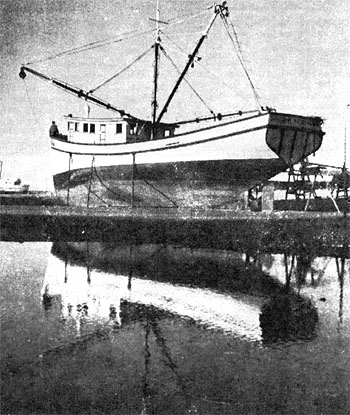
EXCURSION EDITION

PUERTO PENASCO - On the Gulf of California, the village is headquarters for both commercial anrl snort fishing.
MILES FROM K. P.
| MEXICALI | STATIONS | REMARKS |
| 0.00 | Mexicali | Line from the International Border past the station to Pascualitos is the old "Inter-Cal" |
| 5.59 | Pasoualitoa | Former junction of FSBC and the Inter-Cal. Pascualitos is a maintenance-of-way facility |
| 17.40 | Cerro Pristo | |
| 18.02 | Canal Crossing | |
| 25.17 | Delta | |
| 32.31 | Victoria | Look to your left. It's a quaint town |
| 34.49 | Curve to left, then right for pictures | |
| 36.04 | Rio Colorado | Colorado River one-lane rail-highway bridge |
| 41.07 | Coahuila | Market town - included on short trips as a stop |
| 42.87 | Baja-California | State Line |
| 44.49 | Riito | Short excursions turn back here |
| 63.2 | El Doctor | Railroad whistle stop |
| 80.30 | Kilom, 121 | Railroad facility |
| 85.07 | Sanchez Isles | Railroad facility |
| ? | The Crosses | No station, but crosses beside right-of-way mark the graves of surveyors who lost their lives during construction of the railroad |
| 93.07 | Torres B. | Railroad Facility |
| 113.97 | Lopez Collada | Railroad Facility |
| 133.86 | Gustavo Sotelo | Railroad Facility |
| 153.46 | Puerto Penasco | Passengers will disembark at the station and board busses for a short ride to the town |
For more than 67 years, the cruel and forbidding Altar Desert had prevented man from establishing vital lines of land communication between the Territories of Baja California and the Interior of the Republic of Mexico. Not until the advent of the diesel-eiectric locomotive would the building of such a railroad be practical and air conditioning to make the journey fairly comfortable.
On April 7, 1948, Mexican President Miguel Aleman drove the final spike to complete the 325-mile Sonora-Baja California Railroad to join Mexicali via Puerto Penasco to Benjamin Hill, the northern terminus of Mexican rail traffic. For the first time the peninsula of Baja California was united directly by rail with the national network. The building of the Ferrocaril Sonora-Baja California Railroad, the FSBC, was no easy task.
In 1881-2, the first railroad was proposed, from San Diego via Tijuana, Port Isabel in the state of Sonora, across the Altar Desert to a connection with the Sonora Railway, which the Santa Fe was building north from Guayamas. This plan died on paper.
First rails were laid in 1887 when an English Corporation the Mexico Land and Colonization Company planned rail lines from San Quintin, a Pacific Coast Harbor about 195 miles south of San Diego, to San Felipe on the Gulf of California; to Tijuana and San Diego and to Yuma. The Peninsular Railroad was actually built for about 18 miles from San Quintin in 1892. There the railroad ended.
Then came a bold plan of the California Development Co. to irrigate the valley south of the Salton Sink in California with Colorado River water and the Imperial Valley came into being with irrigation in mid-1901. Towns sprang up, Calexico and Mexicali, among others. This caused the importance of the northern part of Baja California to increase.
E. H. Harriman, President of the Southern Pacific Co., sensed the future value of the valley and a rail connection was built from Old Beach, now Niand, junction with the main line between Los Angeles and Yuma to Calexico. Regular service began on June 29, 1904. In December 1905, the Southern Pacific placed a box car on a side track at El Centro to be used as a station.
In the meantime, the San Diego and Arizona railway had been formed by San Diegan John D. Spreckels and E. H. Harriman to build from San Diego via Tijuana, Campo, Carriso Gorge, El Centro, Mexicali to Yuma. However the SP organized the "Campania del Ferrocarril Inter-California" and constructed the railroad from Mexicali via Pascualitos to Algodones, Baja California. There the track crossed back into the United States with an extension to the SP main line. Completed in 1909, this road formed a more direct route for shipments from Mexican Valley to points on the Mexican mainland but round about via Tuscon and Nogales or El Paso. This relieved the SDA from building from El Centro to Yuma. The SDA opened December 1st, 1919, providing service from San Diego and the Tijuana area to cities in the interior of Mexico.
A series of revolutions broke out in 1910 and a new recgime took over. In 1917 the construction of highways from Ensenada to Tijuana and to Mexicali and a railroad from Pascualitos, the junction point with the Inter-California Railway to San Felipe, on the gulf, connecting with the steamer lines.